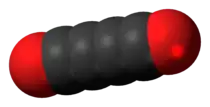 | |
| Names | |
|---|---|
| Preferred IUPAC name
Buta-1,2,3-triene-1,4-dione | |
| Identifiers | |
| |
3D model (JSmol) |
|
| ChemSpider | |
PubChem CID |
|
CompTox Dashboard (EPA) |
|
| |
| |
| Properties | |
| C4O2 | |
| Molar mass | 80.042 |
Except where otherwise noted, data are given for materials in their standard state (at 25 °C [77 °F], 100 kPa).
Infobox references | |
Tetracarbon dioxide is an oxide of carbon, a chemical compound of carbon and oxygen, with chemical formula C4O2 or O=C=C=C=C=O. It can be regarded as butatriene dione, the double ketone of butatriene — more precisely 1,2,3-butatriene-1,4-dione.[1]
Butatriene dione is the fourth member of the family of linear carbon dioxides O(=C)n=O, that includes carbon dioxide CO2 or O=C=O, ethylene dione C2O2 or O=C=C=O, carbon suboxide C3O2 or O=C=C=C=O, pentacarbon dioxide C5O2 or O=C=C=C=C=C=O, and so on.
The compound was obtained in 1990 by Günther Maier and others, by flash vacuum pyrolysis of cyclic azaketones in a frozen argon matrix.[2] It was also obtained in the same year by Detlev Sülzle and Helmut Schwartz through impact ionization of ((CH3-)2(C4O2)(=O)2=)2 in the gas phase.[3] Although theoretical studies indicated that the even-numbered members of the O(=C)n=O family should be inherently unstable,[4] C4O2 is indefinitely stable in the matrix, but is decomposed by light into tricarbon monoxide C3O and carbon monoxide CO.[2][1] It has a triplet ground state.[1]
References
- 1 2 3 J.I.G. Codagan, John Buckingham, Finlay J. MacDonald, P. H. Rhodes (1996), Dictionary of Organic Compounds. CRC Press, ISBN 0-412-54090-8, ISBN 978-0-412-54090-5. 9000 pages
- 1 2 Günther Maier, Hans Peter Reisenauer, Heinz Balli, Willy Brandt, Rudolf Janoschek(1990), C4O2 (1,2,3-Butatriene-1,4-dione), the First Dioxide of Carbon with an Even Number of C Atoms. Angewandte Chemie International Edition, volume 29, p. 905–908.
- ↑ Detlev Sülzle, Helmut Schwartz (1990), Identification of Butatrienedione, Its Radical Anion, and Its Radical Cation in the Gas Phase. Angewandte Chemie International Edition, volume 29, p. 908–909.
- ↑ V. Krishnamurthy and V. H. Rawal (1997), J. Org. Chem., volume 62, 1572.
- François Diederich and Yves Rubin (2003), Synthetic Approaches toward Molecular and Polymeric Carbon Allotropes. Angewandte Chemie International Edition, Volume 31 Issue 9, Pages 1101–1123.